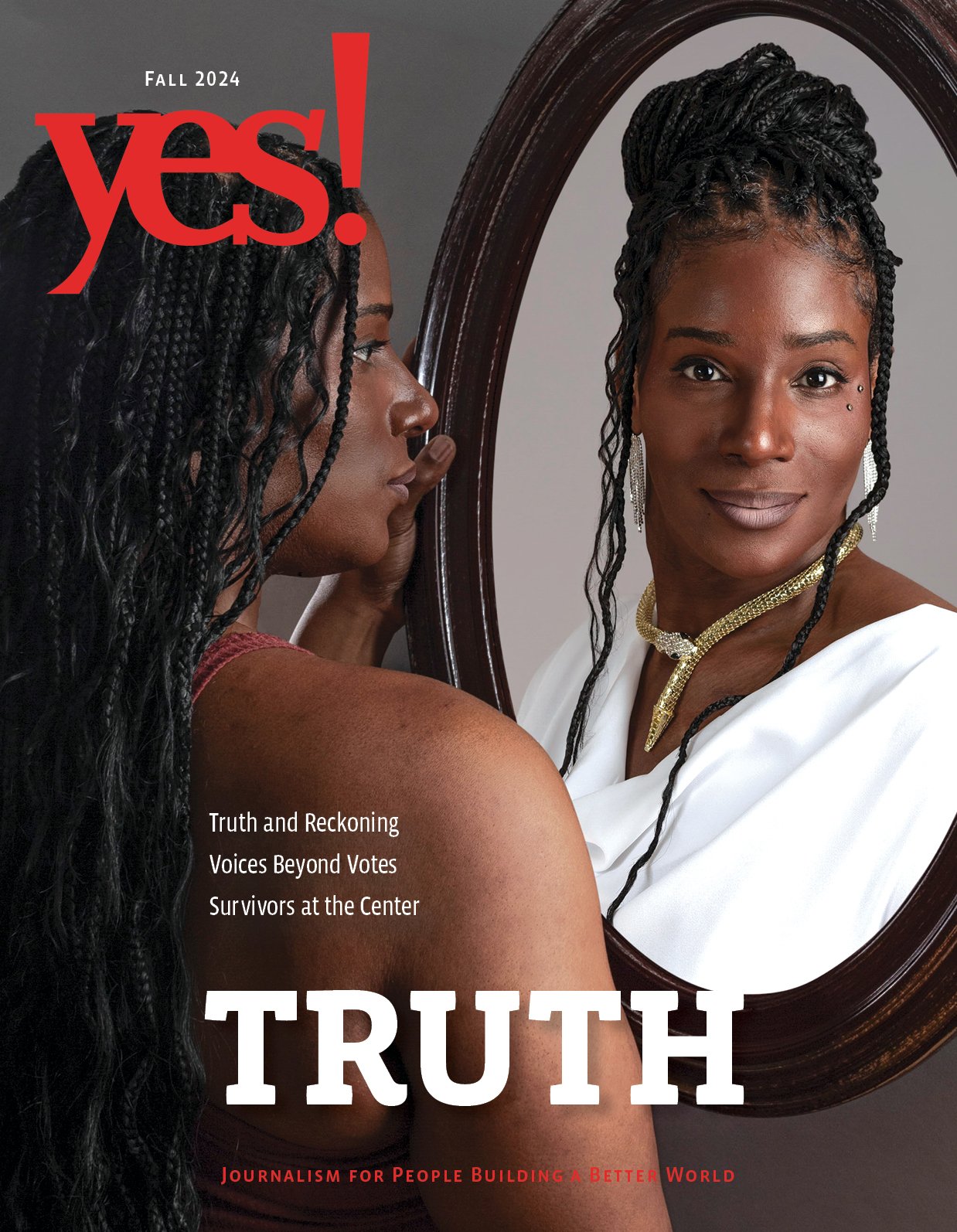
Images, photos, and pictures stimulate the mind. For the viewer, they offer a chance to connect and question. They also offer potential for play and imagination, and pulling the observer into purposeful messages.
Most often, newspaper and magazine readers take a quick glance at photos and their captions. With this YES! lesson plan, you and your students can luxuriate—and pause—to truly understand an image, its message, and why it’s interesting (or not).
Download this lesson as a PDF.
Step 1: What do you notice?
Ask your students to make sense of the photograph by trusting their instincts of observation and inference. The image offers possibilities and interpretations beyond a typical reading where the reader glances at a photograph to reinforce its title or caption. Do not introduce any facts, captions, or other written words. In response to the question “What do you notice?” you may hear: Round bulbs; streaks of orange, yellow, and brown; shiny shapes in a row.
Step 2: What are you wondering?
After you’ve heard your students’ first observations, you may hear a peppering of questions: Why are these shapes arranged in rows? Can you pull them apart? What do they feel like—are they squishy or hard? How big is each individual one?
This is a good time to reveal the photo’s caption and other information about the photo. Watch how the conversation shifts from what they believe to be true to discerning the facts about the photo.
Photo Caption:
“Indian Corn.” Photo by Nancybelle Gonzaga Villarroya
Photo Facts:
- Flint corn, also called Indian corn, is one of the oldest varieties of corn and was a staple food for Indigenous peoples in the Americas. Indian corn has been an ingredient in succotash, mush, tortillas, hominy, nixtamal, cornbreads, and fry breads for centuries. Today, flint corn is grown primarily in Central and South America. It is used for eating and decoration.
- Zea mays is the botanical name for corn or maize. Until at least the turn of the 20th century, Americans typically referred to all corn as Indian corn. Maize, a Spanish derivative of the Arawak or Taino word mahiz, is the preferred term by Britain and most of the world.
- Corn is the nation’s biggest crop. The Corn Belt is Indiana, Illinois, Iowa, Missouri, Nebraska, and Kansas. One acre of corn eliminates 8 tons of carbon dioxide from the air.
- Corn is found in three out of four supermarket products; there are more than 35,000 uses for corn, such as making flour, ethanol, and plastic, and feeding livestock.
- High fructose corn syrup started being manufactured in the 1970s. In 2009, it was estimated that the average American consumes more than 35.7 pounds of corn sweetener each year.
- Corn makes a cow’s normally pH neutral stomach acidic. As a result, cattle are more likely to suffer from health issues, such as bloating and liver damage. To counter the negative effects, cattle are fed antibiotics and consume 70 percent of total antibiotics in the U.S.
Additional Resources:
LEARN: Who Invented Candy Corn? (History Channel)
READ: Tribes Revive Indigenous Crops and the Food Traditions that Go with Them (NPR)
WATCH: Why Corn is the Most Sacred Crop (Forklore)
EXPLORE: King Corn—a feature documentary about two friends, one acre of corn, and the subsidized crop that drives our fast-food nation.
Step 3: What next?
- You may have been taught that dandelions, nettles, and blackberries are weeds that should be removed, while others see these plants having medicinal or other benefits. What plants have you been taught are native or invasive? What is lost (or gained) when native plants or crops, like Indian corn, have disappeared from our fields and forests?
- Globalization gives us year-round access to food products that are typically considered seasonal or foreign due to preservation methods and quick transportation processes. Look in your pantry and refrigerator. Where does your food come from? Does sourcing influence which foods you buy? Can you go without strawberries in the winter?
- Some manufacturers, plus the beef industry, use corn to save money, even though corn may not be the healthiest alternative. In an interview about cattle farming, journalist Michael Pollan says getting a six-month-old calf off grass and on corn speeds up their lifespan, gets them really fat, and allows you to slaughter them within 14 months. How are our consumer choices impacted by industry practices? To what extent do you feel like you have autonomy over the purchases available to you?
- Through the Farm Bill and agricultural subsidies, the government attempts to protect food supply and production from extreme weather and economic crises and ensure farmers can sell their crop above a certain price—in other words, keep farmers in business. Payments don’t go to improving farm practices, like drought prevention, or diversifying crops. The majority of the payments go to the largest producers of corn, soybeans, wheat, cotton, and rice. Do you think subsidies are a good practice? Describe how you might like to see government’s role in the agriculture industry change. What farmers would they help and how?



